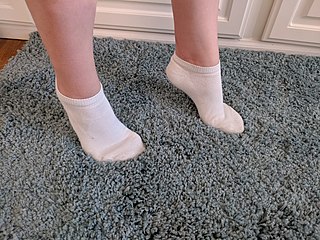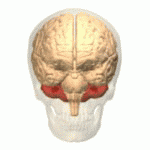
Cerebral palsy (CP) is a group of movement disorders that appear in early childhood. Signs and symptoms vary among people and over time, but include poor coordination, stiff muscles, weak muscles, and tremors. There may be problems with sensation, vision, hearing, and speech. Often, babies with cerebral palsy do not roll over, sit, crawl or walk as early as other children. Other symptoms may include seizures and problems with thinking or reasoning. While symptoms may get more noticeable over the first years of life, underlying problems do not worsen over time.
Spasticity is a feature of altered skeletal muscle performance with a combination of paralysis, increased tendon reflex activity, and hypertonia. It is also colloquially referred to as an unusual "tightness", stiffness, or "pull" of muscles.

The Moro reflex is an infantile reflex that develops between 28 and 32 weeks of gestation and disappears at 3–6 months of age. It is a response to a sudden loss of support and involves three distinct components:
- spreading out the arms (abduction)
- pulling the arms in (adduction)
- crying (usually)
The Bobath concept is an approach to neurological rehabilitation that is applied in patient assessment and treatment. The goal of applying the Bobath concept is to promote motor learning for efficient motor control in various environments, thereby improving participation and function. This is done through specific patient handling skills to guide patients through the initiation and completing of intended tasks. This approach to neurological rehabilitation is multidisciplinary, primarily involving physiotherapists, occupational therapists, and speech and language therapists. In the United States, the Bobath concept is also known as 'neuro-developmental treatment' (NDT).

Periventricular leukomalacia (PVL) is a form of white-matter brain injury, characterized by the necrosis of white matter near the lateral ventricles. It can affect newborns and fetuses; premature infants are at the greatest risk of neonatal encephalopathy which may lead to this condition. Affected individuals generally exhibit motor control problems or other developmental delays, and they often develop cerebral palsy or epilepsy later in life. The white matter in preterm born children is particularly vulnerable during the third trimester of pregnancy when white matter developing takes place and the myelination process starts around 30 weeks of gestational age.
Hypertonia is a term sometimes used synonymously with spasticity and rigidity in the literature surrounding damage to the central nervous system, namely upper motor neuron lesions. Impaired ability of damaged motor neurons to regulate descending pathways gives rise to disordered spinal reflexes, increased excitability of muscle spindles, and decreased synaptic inhibition. These consequences result in abnormally increased muscle tone of symptomatic muscles. Some authors suggest that the current definition for spasticity, the velocity-dependent over-activity of the stretch reflex, is not sufficient as it fails to take into account patients exhibiting increased muscle tone in the absence of stretch reflex over-activity. They instead suggest that "reversible hypertonia" is more appropriate and represents a treatable condition that is responsive to various therapy modalities like drug or physical therapy.
The Institutes for The Achievement of Human Potential (IAHP), founded in 1955 by Glenn Doman and Carl Delacato, provide literature on and teaches a controversial patterning therapy, known as motor learning, which the Institutes promote as improving the "neurologic organization" of "brain injured" and mentally impaired children through a variety of programs, including diet and exercise. The Institutes also provides extensive early-learning programs for "well" children, including programs focused on reading, mathematics, language, and physical fitness. It is headquartered in Philadelphia, with offices and programs offered in several other countries.

Developmental coordination disorder (DCD), also known as developmental motor coordination disorder, developmental dyspraxia or simply dyspraxia, is a neurodevelopmental disorder characterized by impaired coordination of physical movements as a result of brain messages not being accurately transmitted to the body. Deficits in fine or gross motor skills movements interfere with activities of daily living. It is often described as disorder in skill acquisition, where the learning and execution of coordinated motor skills is substantially below that expected given the individual's chronological age. Difficulties may present as clumsiness, slowness and inaccuracy of performance of motor skills. It is often accompanied by difficulty with organisation and/or problems with attention, working memory and time management.
Primitive reflexes are reflex actions originating in the central nervous system that are exhibited by normal infants, but not neurologically intact adults, in response to particular stimuli. These reflexes are suppressed by the development of the frontal lobes as a child transitions normally into child development. These primitive reflexes are also called infantile, infant or newborn reflexes.

Toe walking is a term describing a type of walking style. Toe walking is when a person walks on their toes or the ball of their foot, without putting much or any weight on the heel or any other part of the foot. Toe walking in toddlers is common. Children who toe walk as toddlers commonly adopt a heel-toe walking pattern as they grow older. If a child continues to walk on their toes past the age of three, or cannot get their heels to the ground at all, the medical authorities recommend they be examined by a health professional who is experienced in assessing children's walking.
The Communication Function Classification System (CFCS) for individuals with cerebral palsy (CP) is a five-level classification system which began development at Michigan State University and currently under further refinement at the University of Kentucky. The research, organized and conducted by Dr. Mary Jo Cooley Hidecker, Ph.D., CCC-A/SLP, follows two widely used classification systems for cerebral palsy: the Gross Motor Function Classification System (GMFCS) and the Manual Ability Classification System (MACS). Dr. Ray Kent of the University of Wisconsin–Madison, Dr. Peter Rosenbaum of McMaster University, and Dr. Nigel Paneth of Michigan State University are also an integral part of this research.

Over time, the approach to cerebral palsy management has shifted away from narrow attempts to fix individual physical problems – such as spasticity in a particular limb – to making such treatments part of a larger goal of maximizing the person's independence and community engagement. Much of childhood therapy is aimed at improving gait and walking. Approximately 60% of people with CP are able to walk independently or with aids at adulthood. However, the evidence base for the effectiveness of intervention programs reflecting the philosophy of independence has not yet caught up: effective interventions for body structures and functions have a strong evidence base, but evidence is lacking for effective interventions targeted toward participation, environment, or personal factors. There is also no good evidence to show that an intervention that is effective at the body-specific level will result in an improvement at the activity level, or vice versa. Although such cross-over benefit might happen, not enough high-quality studies have been done to demonstrate it.
Dyskinetic cerebral palsy (DCP) is a subtype of cerebral palsy (CP) and is characterized by impaired muscle tone regulation, coordination and movement control. Dystonia and choreoathetosis are the two most dominant movement disorders in patients with DCP.
The Gross Motor Function Classification System or GMFCS is a 5 level clinical classification system that describes the gross motor function of people with cerebral palsy on the basis of self-initiated movement abilities. Particular emphasis in creating and maintaining the GMFCS scale rests on evaluating sitting, walking, and wheeled mobility. Distinctions between levels are based on functional abilities; the need for walkers, crutches, wheelchairs, or canes / walking sticks; and to a much lesser extent, the actual quality of movement.

Athetoid cerebral palsy, or dyskinetic cerebral palsy, is a type of cerebral palsy primarily associated with damage, like other forms of CP, to the basal ganglia in the form of lesions that occur during brain development due to bilirubin encephalopathy and hypoxic–ischemic brain injury. Unlike spastic or ataxic cerebral palsies, ADCP is characterized by both hypertonia and hypotonia, due to the affected individual's inability to control muscle tone. Clinical diagnosis of ADCP typically occurs within 18 months of birth and is primarily based upon motor function and neuroimaging techniques. While there are no cures for ADCP, some drug therapies as well as speech, occupational therapy, and physical therapy have shown capacity for treating the symptoms.

Ataxic cerebral palsy is clinically in approximately 5–10% of all cases of cerebral palsy, making it the least frequent form of cerebral palsy diagnosed. Ataxic cerebral palsy is caused by damage to cerebellar structures, differentiating it from the other two forms of cerebral palsy, which are spastic cerebral palsy and dyskinetic cerebral palsy.

Spastic cerebral palsy is the type of cerebral palsy characterized by spasticity or high muscle tone often resulting in stiff, jerky movements. Cases of spastic CP are further classified according to the part or parts of the body that are most affected. Such classifications include spastic diplegia, spastic hemiplegia, spastic quadriplegia, and in cases of single limb involvement, spastic monoplegia.
The Manual Ability Classification System (MACS) is a medical classification system used to describe how children aged from 4 to 18 years old with cerebral palsy use their hands with objects during activities of daily living, with a focus on the use of both hands together. Like the Gross Motor Function Classification System (GMFCS), there are five levels - level I being the least impaired, only finding difficulty in tasks needing speed and accuracy, and level V being the most impaired, not being able to handle objects and having severely limited abilities for even simple actions.
Perinatal stroke is a disease where an infant has a stroke between the 140th day of the gestation period and the 28th postpartum day, affecting up to 1 in 2300 live births. This disease is further divided into three subgroups, namely neonatal arterial ischemic stroke, neonatal cerebral sinovenous ischemic stroke, and presumed perinatal stroke. Several risk factors contribute to perinatal stroke including birth trauma, placental abruption, infections, and the mother's health.
Srinivas Gada is an Oxford-based doctor, lecturer and academic. His work revolves around autism/ASD in children, Dyspraxia, Developmental Delay, Learning Disability, Emotional & Behavioural Disorders and Cerebral Palsy. Dr Gada has been teaching at University of Oxford. Dr Sri Gada is an Hon Senior Lecturer since 2007.









